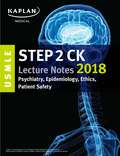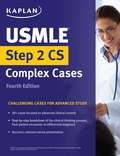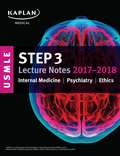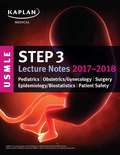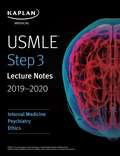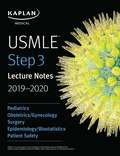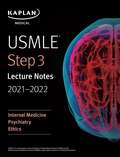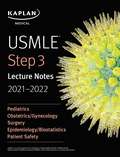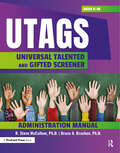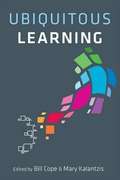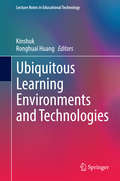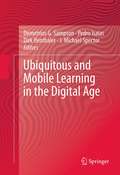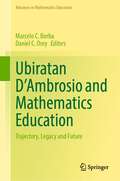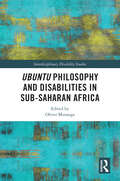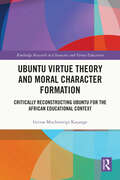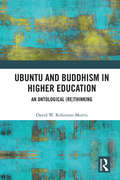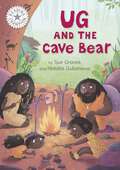- Table View
- List View
USMLE Step 2 CK Lecture Notes 2018: Psychiatry, Epidemiology, Ethics, Patient Safety
by Kaplan MedicalKaplan Medical's USMLE Step 2 CK Lecture Notes 2018: Psychiatry, Epidemiology, Ethics, Patient Safety offers in-depth review with a focus on high-yield topics – a comprehensive approach that will help you deepen your understanding while focusing your efforts where they'll count the most.Used by thousands of medical students each year to succeed on USMLE Step 2, Kaplan's official lecture notes are packed with full-color images and clear review.The Best ReviewOrganized in outline format with high-yield summary boxes for efficient studyBridges between specialties and basic science highlighted throughoutUpdated annually by Kaplan’s all-star expert facultyLooking for more prep? Our USMLE Step 2 CK Lecture Notes 2018: 5-Book Set has this book, plus the rest of the 5-book series.
USMLE Step 2 CK Lecture Notes 2018: Surgery
by Kaplan MedicalKaplan Medical's USMLE Step 2 CK Lecture Notes 2018: Surgery offers in-depth review with a focus on high-yield topics – a comprehensive approach that will help you deepen your understanding while focusing your efforts where they'll count the most.Used by thousands of medical students each year to succeed on USMLE Step 2, Kaplan's official lecture notes are packed with full-color images and clear review.The Best ReviewOrganized in outline format with high-yield summary boxes for efficient studyBridges between specialties and basic science highlighted throughoutUpdated annually by Kaplan’s all-star expert facultyLooking for more prep? Our USMLE Step 2 CK Lecture Notes 2018: 5-Book Set has this book, plus the rest of the 5-book series.
USMLE Step 2 CS Complex Cases: Challenging Cases for Advanced Study
by KaplanMaster the challenging cases. Get beyond the basics with Kaplan's USMLE Step 2 CS Complex Cases, the only guide to focus on challenging cases seen on the USMLE Step 2 Clinical Skills exam. With concise, practical advice on communication, physical exam maneuvers, and differential diagnosis, this slim volume identifies the logic behind each step in the diagnostic reasoning process.Features: * 23 patient cases narrowly focused on advanced clinical content * Step-by-step breakdown of the clinical thinking process, from patient encounter to differential diagnosis * Sample patient notes * Succinct, common-sense presentation
USMLE Step 3 Lecture Notes 2017-2018: Internal Medicine, Psychiatry, Ethics
by Kaplan MedicalThe only official Kaplan Lecture Notes for USMLE Step 3 cover the comprehensive information you need to ace the exam. This 2-volume set is the perfect companion for Kaplan’s USMLE courses.Up-to-date. Updated biannually by Kaplan’s all-star faculty. This updated edition reflects the 2014 test change and includes more foundational medicine and systems-based practice/patient safety.Complete. Includes basic science correlates likely to be tested on the exam, patient management from the experts, patient safety, and population health.Learner-efficient. Case-based content (250+ in-depth cases) organized in outline format presents material for both the Foundations of Independent Practice (FIP) and Advanced Clinical Medicine (ACM) components of the examTrusted. Used by thousands of students each year to succeed on the USMLE Step 3. Two volumes in set: Internal Medicine, Neurology, Psychiatry, Ethics Pediatrics, Obstetrics/Gynecology, Surgery, Epidemiology, Patient Safety This collection of books assumes mastery of both Step 1 pre-clinical discipline-based and Step 2 CK clinical sciences content, both of which are covered in Kaplan's other Lecture Notes bundles.
USMLE Step 3 Lecture Notes 2017-2018: Pediatrics, Obstetrics/Gynecology, Surgery
by Kaplan MedicalThe only official Kaplan Lecture Notes for USMLE Step 3 cover the comprehensive information you need to ace the exam. This 2-volume set is the perfect companion for Kaplan’s USMLE courses.Up-to-date. Updated biannually by Kaplan’s all-star faculty. This updated edition reflects the 2014 test change and includes more foundational medicine and systems-based practice/patient safety.Complete. Includes basic science correlates likely to be tested on the exam, patient management from the experts, patient safety, and population health.Learner-efficient. Case-based content (250+ in-depth cases) organized in outline format presents material for both the Foundations of Independent Practice (FIP) and Advanced Clinical Medicine (ACM) components of the examTrusted. Used by thousands of students each year to succeed on the USMLE Step 3. Two volumes in set: Internal Medicine, Neurology, Psychiatry, Ethics Pediatrics, Obstetrics/Gynecology, Surgery, Epidemiology, Patient Safety This collection of books assumes mastery of both Step 1 pre-clinical discipline-based and Step 2 CK clinical sciences content, both of which are covered in Kaplan's other Lecture Notes bundles.
USMLE Step 3 Lecture Notes 2019-2020: Internal Medicine, Psychiatry, Ethics (USMLE Prep)
by Kaplan MedicalThe only official Kaplan Lecture Notes for USMLE Step 3 cover the comprehensive information you need to ace the exam. This 2-volume set is the perfect companion for Kaplan’s USMLE courses.Up-to-date. Updated biannually by Kaplan’s all-star faculty. This updated edition reflects the 2014 test change and includes more foundational medicine and systems-based practice/patient safety.Complete. Includes basic science correlates likely to be tested on the exam, patient management from the experts, patient safety, and population health.Learner-efficient. Case-based content (250+ in-depth cases) organized in outline format presents material for both the Foundations of Independent Practice (FIP) and Advanced Clinical Medicine (ACM) components of the examTrusted. Used by thousands of students each year to succeed on the USMLE Step 3. Two volumes in set: Internal Medicine, Neurology, Psychiatry, Ethics Pediatrics, Obstetrics/Gynecology, Surgery, Epidemiology, Patient Safety This collection of books assumes mastery of both Step 1 pre-clinical discipline-based and Step 2 CK clinical sciences content, both of which are covered in Kaplan's other Lecture Notes bundles.
USMLE Step 3 Lecture Notes 2019-2020: Pediatrics, Obstetrics/Gynecology, Surgery, Epidemiology/Biostatistics, Patient Safety (USMLE Prep)
by Kaplan MedicalThe only official Kaplan Lecture Notes for USMLE Step 3 cover the comprehensive information you need to ace the exam. This 2-volume set is the perfect companion for Kaplan’s USMLE courses.Up-to-date. Updated biannually by Kaplan’s all-star faculty. This updated edition reflects the 2014 test change and includes more foundational medicine and systems-based practice/patient safety.Complete. Includes basic science correlates likely to be tested on the exam, patient management from the experts, patient safety, and population health.Learner-efficient. Case-based content (250+ in-depth cases) organized in outline format presents material for both the Foundations of Independent Practice (FIP) and Advanced Clinical Medicine (ACM) components of the examTrusted. Used by thousands of students each year to succeed on the USMLE Step 3. Two volumes in set: Internal Medicine, Neurology, Psychiatry, Ethics Pediatrics, Obstetrics/Gynecology, Surgery, Epidemiology, Patient Safety This collection of books assumes mastery of both Step 1 pre-clinical discipline-based and Step 2 CK clinical sciences content, both of which are covered in Kaplan's other Lecture Notes bundles.
USMLE Step 3 Lecture Notes 2021-2022: Internal Medicine, Psychiatry, Ethics (USMLE Prep)
by Kaplan MedicalThe only official Kaplan Lecture Notes for USMLE Step 3 cover the comprehensive information you need to ace the exam. This 2-volume set is the perfect companion for Kaplan&’s USMLE courses.Up-to-date. Updated biannually by Kaplan&’s all-star faculty. This updated edition reflects the 2014 test change and includes more foundational medicine and systems-based practice/patient safety.Complete. Includes basic science correlates likely to be tested on the exam, patient management from the experts, patient safety, and population health.Learner-efficient. Case-based content (250+ in-depth cases) organized in outline format presents material for both the Foundations of Independent Practice (FIP) and Advanced Clinical Medicine (ACM) components of the examTrusted. Used by thousands of students each year to succeed on the USMLE Step 3. Two volumes in set: Internal Medicine, Neurology, Psychiatry, Ethics Pediatrics, Obstetrics/Gynecology, Surgery, Epidemiology, Patient Safety This collection of books assumes mastery of both Step 1 pre-clinical discipline-based and Step 2 CK clinical sciences content, both of which are covered in Kaplan's other Lecture Notes bundles.
USMLE Step 3 Lecture Notes 2021-2022: Pediatrics, Obstetrics/Gynecology, Surgery, Epidemiology/Biostatistics, Patient Safety (USMLE Prep)
by Kaplan MedicalThe only official Kaplan Lecture Notes for USMLE Step 3 cover the comprehensive information you need to ace the exam. This 2-volume set is the perfect companion for Kaplan&’s USMLE courses.Up-to-date. Updated biannually by Kaplan&’s all-star faculty. This updated edition reflects the 2014 test change and includes more foundational medicine and systems-based practice/patient safety.Complete. Includes basic science correlates likely to be tested on the exam, patient management from the experts, patient safety, and population health.Learner-efficient. Case-based content (250+ in-depth cases) organized in outline format presents material for both the Foundations of Independent Practice (FIP) and Advanced Clinical Medicine (ACM) components of the examTrusted. Used by thousands of students each year to succeed on the USMLE Step 3. Two volumes in set: Internal Medicine, Neurology, Psychiatry, Ethics Pediatrics, Obstetrics/Gynecology, Surgery, Epidemiology, Patient Safety This collection of books assumes mastery of both Step 1 pre-clinical discipline-based and Step 2 CK clinical sciences content, both of which are covered in Kaplan's other Lecture Notes bundles.
UTAGS Administration Manual: Universal Talented And Gifted Screener (Other Ser.)
by Bruce Bracken M. Steve McCallumThis is the technical manual for the Universal Talented and Gifted Screener.Universal Talented and Gifted Screener (UTAGS) features up-to-date national norms, is effective with twice-exceptional learners, includes bias-free items, and provides a fair assessment regardless of student demographic characteristics. The UTAGS offers schools a time-saving screener for identifying gifted and advanced learners. Designed to be culturally and linguistically fair, the UTAGS is ideal for schools seeking a nationally normed, statistically sound identification screener. Additionally, the UTAGS includes specific considerations for identifying twice-exceptional learners. UTAGS is designed to screen potentially gifted students in six important areas of school success: cognition,creativity,leadership,literacy,math, andscience.This theoretically sound instrument provides easily interpretable scores in the IQ metric (i.e., Mean = 100; SD = 15) and identifies student strengths/weaknesses in a quick, accurate, and cost-efficient format. UTAGS provides interpretation norms based on a standardization sample of 2,492 participants from 22 states; student demographics closely reflect the United States population. The authors also provide a guide for local norming. Assessment fairness was a strong consideration during the UTAGS development, and teacher raters are requested to focus on effective examinee communication strategies rather than addressing the particular language/communication mode employed by the student. Consequently, examinees from other cultures, those who have speech limitations, or those who use nonstandard English are not unfairly penalized. Ages 5 years 0 months-17 years 11 months
Ubiquitous Learning
by Bill Cope Mary KalantzisThis collection seeks to define the emerging field of "ubiquitous learning," an educational paradigm made possible in part by the omnipresence of digital media, supporting new modes of knowledge creation, communication, and access. As new media empower practically anyone to produce and disseminate knowledge, learning can now occur at any time and any place. The essays in this volume present key concepts, contextual factors, and current practices in this new field. Contributors are Simon J. Appleford, Patrick Berry, Jack Brighton, Bertram C. Bruce, Amber Buck, Nicholas C. Burbules, Orville Vernon Burton, Timothy Cash, Bill Cope, Alan Craig, Lisa Bouillion Diaz, Elizabeth M. Delacruz, Steve Downey, Guy Garnett, Steven E. Gump, Gail E. Hawisher, Caroline Haythornthwaite, Cory Holding, Wenhao David Huang, Eric Jakobsson, Tristan E. Johnson, Mary Kalantzis, Samuel Kamin, Karrie G. Karahalios, Joycelyn Landrum-Brown, Hannah Lee, Faye L. Lesht, Maria Lovett, Cheryl McFadden, Robert E. McGrath, James D. Myers, Christa Olson, James Onderdonk, Michael A. Peters, Evangeline S. Pianfetti, Paul Prior, Fazal Rizvi, Mei-Li Shih, Janine Solberg, Joseph Squier, Kona Taylor, Sharon Tettegah, Michael Twidale, Edee Norman Wiziecki, and Hanna Zhong.
Ubiquitous Learning Environments and Technologies
by Kinshuk Ronghuai HuangThis book focuses on the design and architecture of ubiquitous learning environments, associated technologies, various learning scenarios supported by these environments, and different contexts that arise in environments where the seamless immersion of formal and informal activities and interactions has the potential to contribute to the learning process. With particular focus on adaptivity for individual learners, the book explores the diminishing boundaries of formal and informal learning, and the potential of location-aware context-sensitive approaches that are emerging as successors to the Web 2. 0 paradigm.
Ubiquitous and Mobile Learning in the Digital Age
by Dirk Ifenthaler J. Michael Spector Pedro Isaias Demetrios G. SampsonThis edited volume with selected expanded papers from CELDA (Cognition and Exploratory Learning in the Digital Age) 2011 (http://www.celda--conf.org/) will focus on Ubiquitous and Mobile Informal and Formal Learning in the Digital Age, with sub-topics: Mobile and Ubiquitous Informal and Formal Learning Environments (Part I), Social Web Technologies for new knowledge representation, retrieval, creation and sharing in Informal and Formal Educational Settings (Part II), Virtual Worlds and Game--based Informal and Formal Learning (Part III), Location--based and Context-- Aware Environments for Formal and Informal Learning Integration (Part IV) There will be approximately twenty chapters selected for this edited volume from among peer--reviewed papers presented at the CELDA (Cognition and Exploratory Learning in the Digital Age) 2011 Conference in Rio de Janeiro, Brazil in November, 2011.
Ubiratan D’Ambrosio and Mathematics Education: Trajectory, Legacy and Future (Advances in Mathematics Education)
by Marcelo C. Borba Daniel C. OreyThis edited volume is written in memoriam of Professor Emeritus Ubiratan D’Ambrosio (1932 – 2021), who was a well-known Brazilian mathematics educator and historian of mathematics. This book explores the diverse facets of D’Ambrosio’s work as well as his legacy and the later adaptation of his ideas around the globe.It starts with a preface written by his son, Alexandre D' Ambrosio, who shares his personal experiences growing up with this father and his love for discovery. The book is then divided into four sections:Past and Future: Ubi’s Way of Seeing Education in the PresentRoots of EthnomathematicsEthnomathematics in ActionTrends in Ethnomathematics It features diverse points of view and experiences that explore mathematics and culture from researchers in the Americas, Africa, Europe and South Asia. Chapters range from personal explorations of D’Ambrosio’s impact to broader views of his research and work. This book forms part of the growing understanding of Ubiratan D’Ambrosio’s life, research, and the legacy he has left for millions of researchers, students and teachers worldwide. This book is appealing to anyone involved in mathematics education research as well as those interested in the history and future of mathematics education.
Ubuntu Philosophy and Disabilities in Sub-Saharan Africa (Interdisciplinary Disability Studies)
by Oliver MutangaThis book uses Ubuntu philosophy to illuminate the voices of people with disabilities from Sub-Saharan Africa. Disability literature is largely dominated by scholars and studies from the Global North, and these studies are largely informed by Global North theories and concepts. Although disability literature in the Global South is now fast growing, most studies continue to utilise conceptual, theoretical, and philosophical frameworks that are framed within Global North contexts. This presents two major challenges: Firstly, the voices of people with disabilities in the Global South remain on the fringes of disability discourses. Secondly, when their voices are heard, their realities are distorted. This edited book, consisting of 11 chapters, provides case studies from Botswana, Ghana, Lesotho, Uganda, and South Africa, explores disability in various fields: Inclusive education, higher education, environment, Open Distance Learning, and Technical and Vocational Education and Technical Colleges. The book contributes to the ways in which disability is understood and experienced in the Global South thereby challenging the Western hegemonic discourses on disability. This collection of contributions will be of interest to all scholars and students of disability studies, development studies, medical sociology, and African studies.
Ubuntu Virtue Theory and Moral Character Formation: Critically Reconstructing Ubuntu for the African Educational Context (Routledge Research in Character and Virtue Education)
by Grivas Muchineripi KayangeThis book investigates the ubuntu theory-based conception of virtue and moral character formation in the northern, western, and eastern regions of Africa, suggesting a critical reconstruction of ubuntu by conceptualising the four different forms of practices in moral character formation. Arguing for the critical reconstruction of ubuntu virtue theory as more nuanced than simply the standard ubuntu normative virtue theories (which give priority to the community as the sole locus for understanding virtues and character formation in Africa), the book builds a comprehensive model of virtue and moral character formation that draws insights from the reconstructed notion of ubuntu and other theories within and beyond the African thought. Chapters feature experience from across Africa including Malawi, Zambia, Zimbabwe, Uganda, Kenya, and South Africa, and centre on topics such as traditional cultural views and practices, political systems in various nations, neoliberalist thought, and primary, secondary and tertiary education systems in Africa and further afield. This is a valuable resource for scholars, academics, and postgraduate students, working in the fields of moral and values education, philosophy of education, and the theory of education more broadly. Those also interested in educational psychology may also find the volume of interest.
Ubuntu and Buddhism in Higher Education: An Ontological Rethinking
by David Robinson-MorrisUbuntu and Buddhism in Higher Education theorizes the equal privileging of ontology and epistemology towards a balanced focus on ‘being-becoming’ and knowledge acquisition within the field of higher education. In response to the shift in higher education’s aims and purposes beginning in the latter half of the 20th century, this book reconsiders higher education and Western subjectivity through southern African (Ubuntu) and Eastern (Buddhist) onto-epistemologies. By mapping these other-than-West ontological viewpoints onto the discourse surrounding higher education, this volume presents a vision of colleges and universities as transformational institutions promoting our shared connection to the human and non-human world, and deepens our understanding of what it means to be a human being.
Udemy. Haz dinero enseñando en línea
by Victor Manuel Lopez Ortega Rob JusticeEnseña una materia. Grábalo en video. Súbelo a Udemy. Genera ingreso pasivo. ¿Suena simple? ¡Lo es, pero primero necesitas conocer los secretos y consejos para encontrar el éxito en Udemy!
Udemy: Gagner de l’argent en enseignant en ligne
by Rob JusticeEnseignez une discipline. Faites un enregistrement vidéo de votre cours. Chargez la vidéo de votre cours sur Udemy. Gagnez-en un revenu passif. Cela vous paraît simple ? Ça l'est effectivement, mais vous devez d'abord connaître les secrets et les astuces pour réussir sur Udemy ! Udemy est une plateforme en ligne à croissance explosive, qui enseigne au monde entier des concepts allant de Microsoft Excel à la création de magnifiques jardins. Si vous maitrisez un domaine quelconque - le Surf sur neige, le Copywriting, les mathématiques ou l'histoire (ou n'importe quel autre sujet!) - vous pouvez créer des vidéos pour enseigner vos compétences ET gagner de l'argent par la même occasion. Ce livre vous apprendra à le faire ! Dans ce livre: 1. vous apprendrez tout ce que vous devez savoir pour préparer votre cours Udemy ; 2. vous aurez un guide pour la création de votre premier cours Udemy ; 3. vous bénéficierez de conseils pour réaliser vos conférences vidéo Udemy ; 4. vous saurez comment commercialiser avec succès votre cours Udemy ; 5. vous aurez un aperçu des cours Udemy populaires et les catégories de cours Udemy disponibles. Apprenez les compétences et les astuces qui vous sont nécessaires pour réussir sur la plus grande plateforme d'éducation en ligne aujourd'hui : Udemy. Achetez ce livre et commencez dès aujourd'hui !
Udemy: Guadagna Insegnando Online
by Rob JusticeInsegna qualcosa. Regista un filmato. Caricalo su Udemy. Comincia a guadagnare passivamente. Sembra semplice? Lo è, ma prima devi trovare i segreti ed i suggerimenti per il successo su Udemy!
Udyamita Vikas (Foundation course) B.A. B.Sc. B.Com. B.H.Sc. First Year SEM-I and SEM-II - M.P. University
by Madhya Pradesh Hindi Granth Academy BhopalUdyamita Vikas (Foundation course) text book for B.A., B.Sc., B.Com., B.H.Sc. First Year SEM-I and SEM-II According to the Latest Syllabus based on syllabus from Madhya Pradesh Hindi Granth Academy Bhopal in Hindi.
Udyojakiy Arthashastra First Semester FYBA New NEP Syllabus - RTMNU: उद्योजकीय अर्थशास्त्र पहिले सत्र एफ.वाय.बी.ए. नवीन एन.इ.पी. अभ्यासक्रम - राष्ट्रसंत तुकडोजी महाराज नागपूर विद्यापीठ
by Prof. Dr. Rakshit Madan Bagde‘उद्योजकीय अर्थशास्त्र’ हे प्रा. डॉ. रक्षित मदन बागडे यांचे पुस्तक बी.ए. (अर्थशास्त्र) प्रथम वर्षाच्या नवीन अभ्यासक्रमानुसार लिहिलेले असून, महाराष्ट्रातील विविध विद्यापीठांतील विद्यार्थ्यांसाठी अत्यंत उपयुक्त आहे. या पुस्तकात उद्योजक, उद्योजकता, व्यवसाय विकास, उद्योजकीय उपक्रम, वित्तीय संसाधने, व्यावसायिक योजना व शासनाच्या योजनांचा सखोल अभ्यास दिला आहे. उद्योजकता म्हणजे केवळ व्यवसाय सुरू करणे नसून, नाविन्य, धाडस, आर्थिक जोखीम स्वीकारणे आणि समाजाच्या परिवर्तनात भूमिका बजावणे असे व्यापक रूप आहे, हे पुस्तक विद्यार्थ्यांना समजावते. ग्रामीण उद्योजकता, महिला उद्योजकता, सामाजिक उद्योजकता अशा विविध अंगांचा यात समावेश असून, स्टार्ट-अप इंडिया, मेक इन इंडिया, मुद्रा योजनेसारख्या योजनांची माहितीही पुरवली आहे. उद्योजक आणि व्यवस्थापक यामधील फरक, उद्योजकतेची वैशिष्ट्ये, कार्य, संधी, अडचणी आणि उपाययोजना यांचे समावेश हे पुस्तक विशेषत्वाने प्रगल्भ करते. व्यावसायिक जगतात प्रवेश करू इच्छिणाऱ्या तरुणांसाठी, हे पुस्तक मार्गदर्शक ठरते.
Ug and the Cave Bear: Independent Reading White 10 (Reading Champion #517)
by Sue GravesThis story is part of Reading Champion, a series carefully linked to book bands to encourage independent reading skills, developed with Dr Sue Bodman and Glen Franklin of UCL Institute of Education (IOE) Fantastic, original stories are accompanied by engaging artwork and a reading activity. Each book has been carefully graded so that it can be matched to a child's reading ability, encouraging reading for pleasure. Perfect for 7-9-year-olds or those reading book band white.Ug's family needs the fire for their cave. It keeps them warm and safe from wild animals. One day, Ug is so busy painting that he forgets all about it...
Ugc Net Education (Theory & MCQ) Competitive Exam
by Indic TrustThe Book Ugc Net Education as a subject gained popularity among students. At present there is a dearth of good book on education. We tried to fill this vaccum and satisfy the need of the student. This book also providespractical guidance on the stages of a research project. The study material as per the UGC syllabus on education is given at the beginning of each chapter, heading and sub-heading are included for easy reference
Ugc Net Geography Solved Paper (2006-2017) Competitive Exam
by Indic TrustThis book is a collection of Questions & Answer of last 10 years (2006 - 2017) of Geography Paper for U.G.C Net students would find it very useful in understanding the types of questions being asked in the examination.
